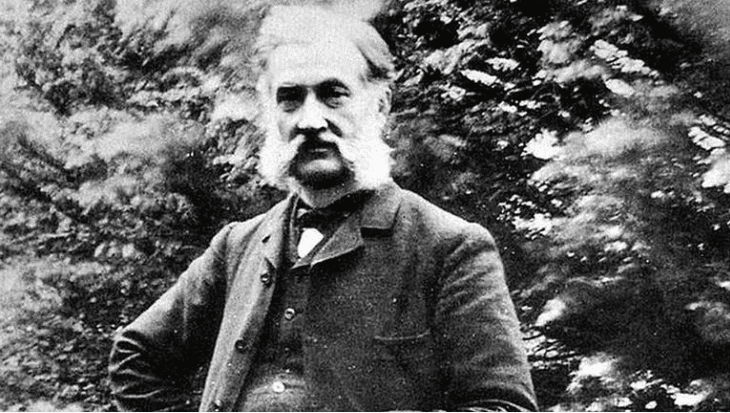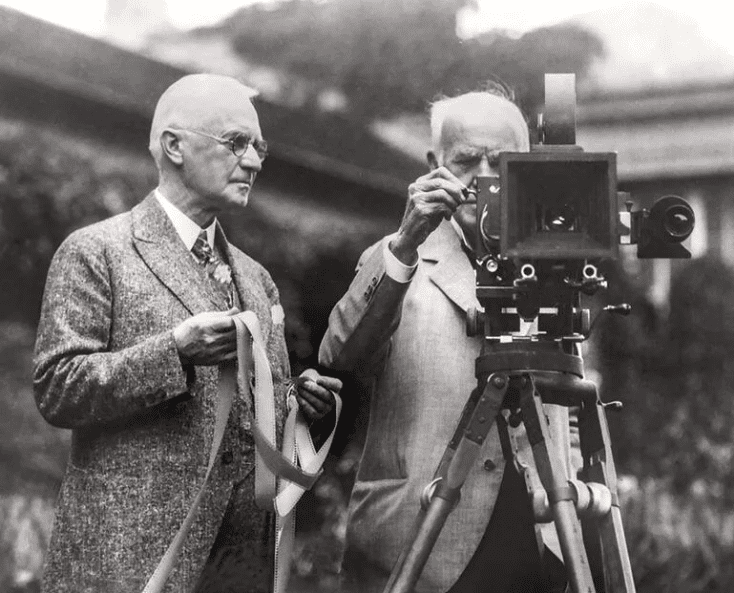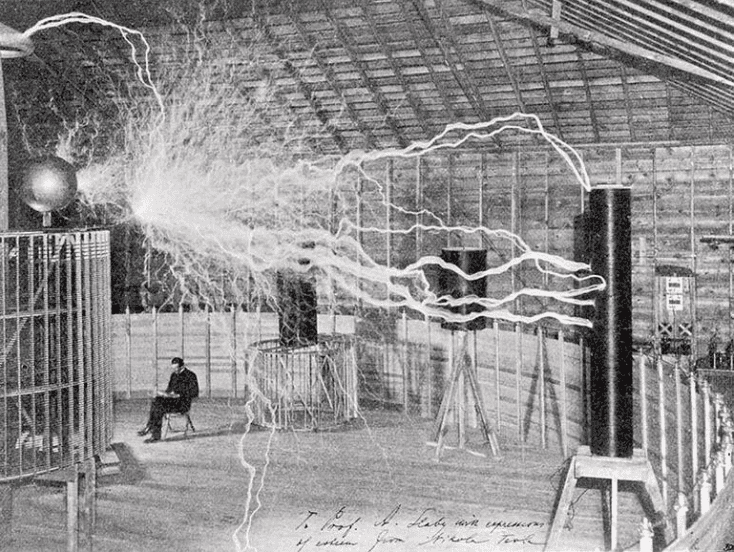The name Louis Le Prince means almost nothing to any of us today, but this French inventor who lived in the 1800s actually has a very important place in the history of art and entertainment. Here are the unexpected developments behind the scenes of a mysterious death…
The calendars showed September 1890. Frenchman Louis Le Prince’s train from Dijon was on its way to Paris. Le Prince, a former chemist and technical painter, made his debut two years before this train journey and managed to make the world’s first moving film. The two-second film filmed some members of the Le Prince family strolling through the garden of their home in Leeds, England, where they lived at the time.

The shooting took place three years before Thomas Edison announced to the world that he had invented a camera-like device called a “kinetograph”, and seven years before the Lumiere Brothers had their first commercial cinema screening.
- The Vikings sent manatee tusks from Greenland to Kiev
- Chernobyl on the Anniversary: The Truth About the Nuclear Disaster
By contrast, Le Prince’s contribution to the history of cinema disappeared amid the dusty pages of history. Because when the train from Dijon arrived in Paris on that September day in 1890, Le Prince was not among those who landed. Le Prince suddenly disappeared and has not been heard from since.
At the time of his disappearance, Le Prince was going through a really hard time. On the one hand, he was in debt, his creditors were knocking on his door. On the other hand, it put incredible pressure on his opponents, especially Edison.
EDISON HAD HIM KILLED? Did he commit suicide?
As a result, Le Prince’s disappearance raised many questions. Could Edison have had his opponent killed? Was that a suicide? Or did Le Prince’s brother Alfred, who owed him a lot of money, choose to eliminate his brother instead of paying him back?
A book that hit shelves in the US on April 19 takes a closer look at Le Prince’s life as he searches for answers to these questions. In “The Man Who Invented Motion Pictures: A True Tale of Obsession, Murder and the Movies,” author Paul Fischer concludes that a detailed investigation has led to important conclusions about Le Prince’s fate.
According to Fischer, his brother Alfred is responsible for Le Prince’s disappearance. The author calls alfred the killer, based on alfred’s failure to report his brother missing to the security forces, lying about the search and dissuading his wife, who was living in the United States at the time, from going to France and looking for Le Prince.
“Le Prince did not leave behind letters or notes indicating that he would end his life. His colleagues and family could not see any signs of despair in him. Moreover, he had made plans for the future, he wanted to travel to New York and introduce his invention to the world.”
WHAT WAS LE PRINCE’S PLACE IN THE HISTORY OF CINEMA?
But the most interesting element of Fischer’s book is not the death of Le Prince. Based on extensive research, the book is as important as Le Prince’s life, as it is about the history of photography and its efforts to transition from still image to moving image. “I hope this book can make us think differently about what happened in the days when cinema was invented,” Fischer says.
Fischer’s story is full of legendary names in the history of photography and cinema. Louis Daguerre, considered one of the fathers of the photograph, was the first to photograph the models moving, Eadweard Muybridge (objects photographed before Muybridge had to stand still for a while) George Eastman, founder of the Eastman Kodak Company (Kodak cameras with emulsion-covered paper reels placed inside, replaced glass panels and a huge improvement was accepted) and John Carbutt (Eastman later perfected the celluloid film) he started using it on cameras) a few of them.
PATENT LAWS THAT CHANGE EVERYTHING
It is possible to accept these names more or less as contemporary. They are all people who benefited from the incredible advances in technology between 1840 and 1890. This is the invention of photography, telegraphy, steam engine, anesthesia, phone, electric light and many more.
Fischer notes that patent laws are the driving force behind a significant part of this rapid technological advancement.
“When you were able to show that you invented something and that you were the first to do it, you could patent it, and no one could make money from it without your permission. Each progress brought the next progress because new areas were opening up each time to make further progress, and each of these advances meant money.”
-
According to the writer Paul Fischer, if Le Prince had lived, there might not exist in Hollywood today.

EDISON AND ASKI APPLICATIONS
“The Man Who Invented Motion Pictures” tells the story of the technological advances that made today’s motion pictures possible throughout the pages, but in essence focuses on whose household this invention was written into and the legal issues behind it. This is the part of the subject that will resonate most in today’s context.
Because in the end, it’s tied up at Edison
Edison, the inventor of many devices still used today, was the ancestor of the tech company bosses of our time in the 19th century. Edison, which has also been very successful in using loopholes in the law to defeat its opponents, today describes it as a “combination of Donald Trump and Steve Jobs.”
One of Edison’s favorite legal mechanisms was the suspension application. The person applying for the hanger, which is a kind of pre-patent, had instilled an intention to make the formal application regarding the final version of his invention soon. As a result of the application, the person had obtained a priority right regarding the device he invented. Edison used this mechanism to knock its competitors out of the race.
When someone else applied for similar inventions that Edison applied for, the Patent Office put that application on hold and informed Edison that it had three months to make the formal application. It’s in the records that Edison used this mechanism for 120 different devices.
There is speculation that Edison’s interest in moving video recording began before 1888. But eadweard muybridge’s visit to Edison’s laboratory in West Orange in February of that year was certainly a major factor. Muybridge, who developed the instrument “zoopraksiskop”, which records moving images, offered to combine Edison’s audio recording phonograph device with this device. Edison found the offer exciting, but declined. (Underlying this may be the realization that zoopraksisscope is not a practical and efficient tool for image recording.) Then, on October 17, 1888, he filed a suspension application with the Patent Office to preserve his future inventions. The application mentioned the idea of “a device that will make what the phonograph does for the ear for the eye.” This device would record moving objects and then recreate that record. Edison called his invention a “kinetoscope.” The word consisted of a combination of “kineto”, which means “movement” in Greek, and “scopy”, which means to watch.
COULDN’T CHANGE THE DATE NO MATTER WHAT
To be fair, Le Prince is the inventor of film reels, a single-lens camera and a single-lens camera, but his success was not noted by the subtle legal moves of Edison (which some found illegitimate).
Fischer compared Edison’s patent cunning to today’s technology companies, saying that “many of the evils attributed to Edison are no different from the practices of today’s big companies.”
“He discredited his opponents, sometimes stole from them, and often dragged his smaller opponents into ruin with lawsuits. Edison’s exploitation of the patent system was similar in many ways, with companies like Disney now using their weight and exploiting copyright laws for their own benefit.”
Still, it was not possible to change the date. It is indisputable that the two-second video shot by Le Prince, now known as the “Roundhay Garden Scene”, is the oldest known moving image recording. Fischer says the image is a small indication of Le Prince’s intentions and hopes for new technology.
https://youtu.be/a68sxQK3Gc0
VERY DIFFERENT FROM EDISON AND THE LUMIERE BROTHERS.
“When I saw Roundhay Garden Scene, the first thing that came to mind was ‘home shoot’,” Fischer said.
“I think that’s one of the reasons you love this image so much. Le Prince saw the film as something that would connect people in the first place, preserve memories, and make us remember our loved ones even after we lost them. The scene really struck me because it carries such innocence and spontaneity.”
Fischer notes that this is very different from the first images taken by Edison and the Lumiere Brothers, in which they “shoot small sketches that show the innovation of their inventions,” as in the case of a crowd of workers leaving a factory or a train speeding towards the audience.
“Le Prince knew that big shows were important. Early ideas included shooting at the circus or buffalo bill’s Wild West Show. But for that first film, he chose to film the moments when he walked around the garden of his family’s house.”

IF LE PRINCE WERE ALIVE…
Fischer also suggests that Le Prince’s disappearance may have changed the course of history. How’s that? Years after Le Prince disappeared, Edison won patent battles and formed a monopoly along with many other companies. This monopoly began to charge licensing fees to all producers, distributors and screeners. This led to independent producers fleeing the East Coast of the US and gathering in the newly formed Hollywood town. But would things have been different if Le Prince were alive?
“If Le Prince had lived and had not lost control of his invention, there might not be such a thing as Hollywood today,” Fischer says.
“Maybe the independent cinema ecosystem would be healthier. Because Le Prince seems to want the film camera to be spread like a camera. Of course, not much could have changed… But probably the kids would have read about Louis Le Prince’s life at school, and the movie world would have a longer life in New York.”

- One of the best-known details about Edison’s patent cunning is its relationship with Nikola Tesla. Tesla’s rapidly growing fan base in recent years suggests that Edison has gained unfair profits and reputations by exploiting and patenting the Serbian inventor’s ideas. The origin of this competition, which has become almost an element of popular culture, lies in the spread of electricity. To summarize briefly, Tesla, 28, moved from his home country to New York in 1884 and began working as an assistant to Edison, who was 37 at the time. At that time, Edison established its own laboratory and launched the Edison Lighting Company. A year later, Tesla left Edison’s side and took steps to build its own light-up company. The system he used was based on the principle of induction motors powered by fluctuating current. The incident, which opened the gap between the two giants, occurred at the point of setting the universal US electricity current standard. Edison preferred the widely used correct current (DC) (and, thanks to its patents, made an acceptable amount of money through this system). But the correct current had a downside: it was very difficult to convert the low voltage from power plants into high voltage transmission lines and transmit them to remote locations. Therefore, a large number of small power plants had to be built near the cities. Tesla’s fluctuating current (AC) system solved this problem. Through transformers, voltages could be raised and lowered, and electricity could be easily transmitted even if power plants were miles away. Tesla sold its patents to George Westinghouse, who introduced the AC system as a competitor to Edison’s. These “current wars” really opened up between the two for a while. Edison launched advertising campaigns for DC, even trying to shape public opinion by having an elephant named Topsy slammed with AC in front of people. But the war was short-lived and Edison lost. In 1893, westinghouse won the tender to provide electricity for the World’s Fair. In 1896, General Electric switched from DC to AC. AC eventually became the dominant system in the US. Tesla, on the other hand, soon embarked on new inventions. In 1892, he was teaching at a university in London and working on a radio idea. Historians note that this dispute is not an epic war, but an ordinary friction that often occurs in the business world and is not as great as it is described today. “Edison wasn’t worried about Tesla,” said W. Bernard Carlson, who also has a book about Tesla. On the contrary, he idolized her when she worked for him. He was angry, but it wasn’t a lifelong animosity as described.” Many historians who have written Tesla’s biography note that the serbian inventor’s main rival is Guglielmo Marconi, who “invented” radio using his work.
The Daily Beast’in “He Shot the World’s First Motion Picture—and Then Disappeared Forever”, Vox’un “Tesla vs. Edison — and what the never-ending battle says about us” ve Library of Congress’in “Origins of Motion Pictures” resources used




